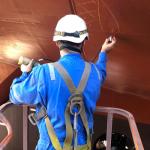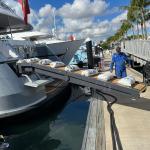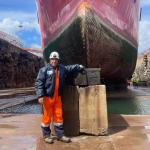MV Golden Ray (2019): A Case Study in Effective Maritime Search and Rescue Operations
In September 2019, the MV Golden Ray, a car carrier, capsized while departing the Port of Brunswick in St. Simons Sound, Georgia, USA. This incident underscores the critical role of the Global Maritime Distress and Safety System (GMDSS) and highlights the effectiveness of modern maritime communication and rescue technologies in Sea Area A1.
Incident Overview
The MV Golden Ray, carrying approximately 4,200 vehicles, encountered trouble shortly after leaving the port. The vessel tilted heavily to one side before capsizing, trapping 24 crew members on board. Thanks to the rapid deployment of GMDSS protocols and devices, all 24 crew members were rescued, showcasing the importance of preparedness and the efficiency of maritime safety systems.
Sea Area A1: The Critical Zone
Sea Area A1 is defined as the area within the range of VHF coast stations, typically extending up to 20-30 nautical miles from shore. This zone ensures reliable communication via VHF DSC (Digital Selective Calling), which allows for immediate distress alerting and the coordination of rescue operations. The MV Golden Ray incident occurred within this zone, highlighting the effectiveness of the GMDSS in facilitating timely and efficient rescue efforts.
Devices and Systems Used in the Rescue
- VHF DSC Radio:
- Role: The VHF DSC radio was used to send distress alerts and establish communication with nearby vessels and shore-based rescue coordination centers (RCC). The digital selective calling feature allowed for precise and automated distress signaling, ensuring that the call for help was received by all relevant parties.
- Impact: Enabled the rapid dissemination of the distress signal, initiating the rescue operation almost immediately after the incident occurred.
- NAVTEX:
- Role: NAVTEX (Navigational Telex) broadcasts provided crucial maritime safety information (MSI) to ships in the vicinity. This included updates on the incident and coordination instructions for vessels that could assist in the rescue.
- Impact: Ensured that all ships in the area were aware of the incident and could adjust their operations to assist in the rescue efforts if necessary.
- Emergency Position-Indicating Radio Beacon (EPIRB):
- Role: The EPIRB was activated to transmit the location of the MV Golden Ray. This device sends a distress signal, including the vessel's position, to satellite networks, which then relay the information to RCCs.
- Impact: Provided accurate location data, enabling rescue teams to quickly locate the capsized vessel and plan their approach.
- Search and Rescue Transponder (SART):
- Role: The SART was used to enhance the visibility of the MV Golden Ray on radar screens of nearby vessels and rescue helicopters.
- Impact: Improved the ability of rescue units to pinpoint the exact location of the distressed vessel, especially in poor visibility conditions.
- VHF Direction-Finding Equipment:
- Role: This equipment was used by rescue vessels to home in on the VHF signals emitted by the distressed ship and its crew.
- Impact: Facilitated precise navigation towards the source of the distress signals, speeding up the rescue process.
The Rescue Operation
The coordinated use of these devices and systems enabled a swift and effective rescue operation. The distress alert sent via the VHF DSC radio was immediately picked up by the United States Coast Guard (USCG) and nearby vessels. The activation of the EPIRB provided precise location data, while NAVTEX broadcasts kept the maritime community informed.
Rescue teams, including the USCG and local marine units, deployed rapidly. VHF direction-finding equipment and SARTs guided rescue boats and helicopters to the site. Despite challenging conditions, all 24 crew members were safely evacuated from the capsized vessel.
Conclusion
The MV Golden Ray incident serves as a powerful reminder of the importance of the GMDSS in maritime safety. The timely and effective use of VHF DSC radios, EPIRBs, NAVTEX, SARTs, and direction-finding equipment ensured a successful rescue operation, saving all crew members on board. This case study highlights the critical role of advanced communication and rescue technologies in enhancing maritime safety and underscores the need for continued investment in and adherence to GMDSS protocols.




